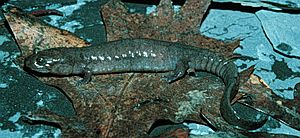Ouachita dusky salamander facts for kids
Quick facts for kids Ouachita dusky salamander |
|
|---|---|
 |
|
| Conservation status | |
| Scientific classification |
The Ouachita dusky salamander (Desmognathus brimleyorum) is a cool type of salamander. It belongs to a family called Plethodontidae. This means it doesn't have lungs! Instead, it breathes through its skin and the lining of its mouth.
This special salamander lives only in the United States, in the states of Arkansas and Oklahoma. It was named after two zoologists, Herbert Hutchinson Brimley and his younger brother, Clement Samuel Brimley.
Contents
What Does It Look Like?
The Ouachita dusky salamander can grow to be about 17.8 centimeters (7 inches) long. This measurement includes its tail, which has a fin-like shape.
Its upper body is usually a greenish-brown or gray color. This color is quite even all over. Young salamanders have a row of pale spots along each side of their body. You can also see fourteen small grooves, called costal rib grooves, on each side of its body.
Where Does It Live?
The Ouachita dusky salamander lives in the mountains of Arkansas and Oklahoma. You can find it in places like the Ouachita Mountains and Petit Jean Mountain. Other areas include Rich Mountain, the Winding Stair Mountain National Recreation Area, and the Kiamichi Mountains.
These salamanders like to live in and near mountain streams. They also live in the ravines and woodlands close to these streams. You might find them on rocky slopes, in gravelly areas, on islands, and near natural springs.
Life Cycle and Reproduction
Ouachita dusky salamanders usually breed between July and September. The female salamander lays about twenty to thirty eggs. These eggs stick together in a cluster, looking a bit like a bunch of grapes.
She often places her eggs under rocks or in small mud chambers on land. The mother salamander stays with her eggs and protects them until they hatch. After hatching, the tiny larvae make their way to the water.
At first, the larvae hide in the spaces between stones and other bits of debris on the streambed. They eat other small creatures. The larvae spend the winter in the water. The following summer, they change into adult salamanders. This process is called metamorphosis.
Conservation Status
The Ouachita dusky salamander is listed as "Least concern" on the IUCN Red List of Threatened Species. This means that scientists are not very worried about it becoming endangered right now.
While their numbers might be slowly going down, experts believe there are more than 10,000 of these salamanders across their home range. The biggest threat to them is when streams get filled with silt. This can happen because of logging nearby. However, if the streams recover, the salamanders often move back into the area.
See also
 In Spanish: Salamandra oscura de Ouachita para niños
In Spanish: Salamandra oscura de Ouachita para niños


